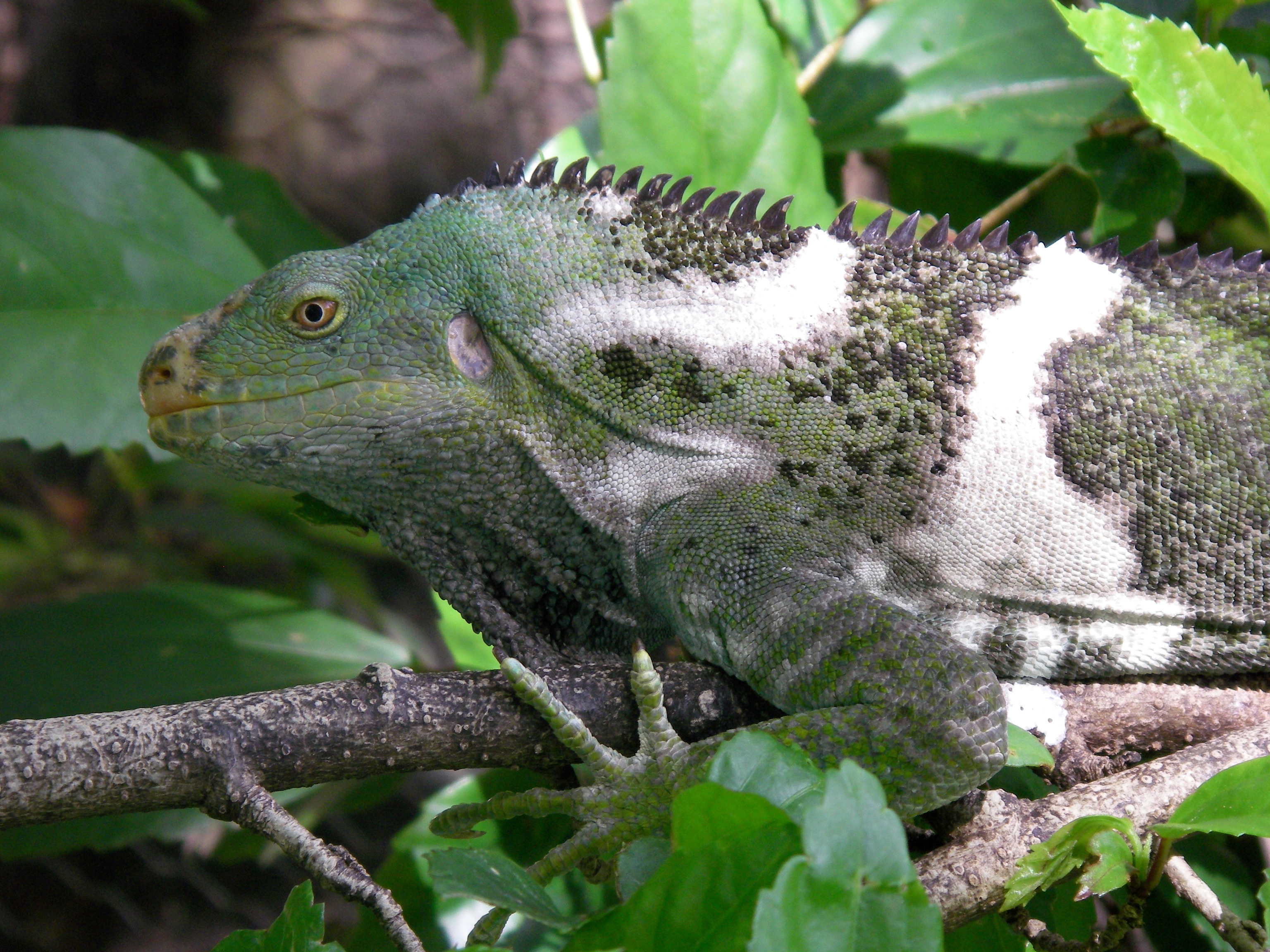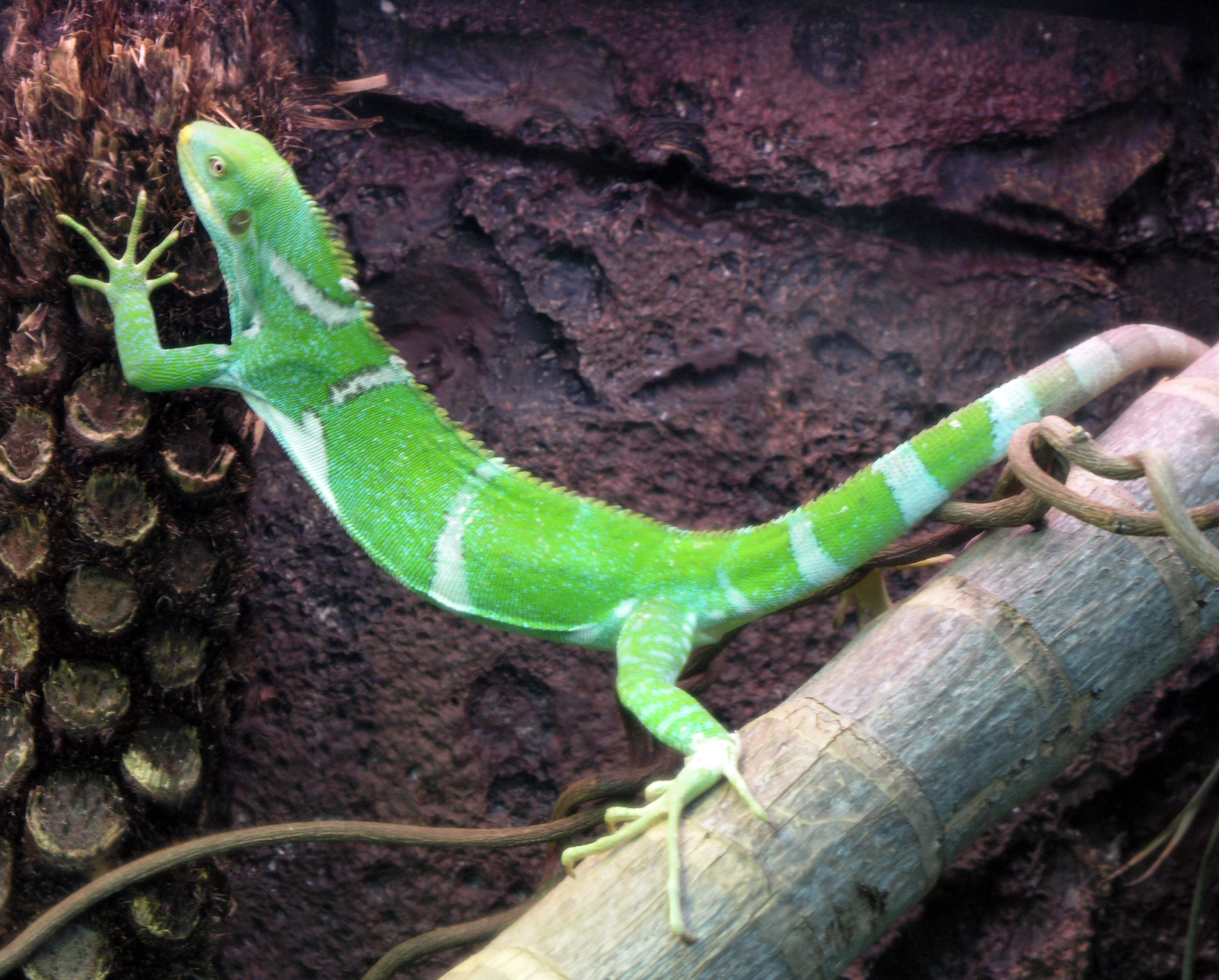- Fiji Crested Iguana
Taxobox
name = Fiji Crested Iguana
status = CR
status_system = iucn2.3
status_ref = IUCN2006|assessors=Australasian Reptile & Amphibian Specialist Group|year=1996|id=2965|title=Brachylophus vitiensis |downloaded=6 October 2008]

image_width = 250px
image_caption = A Fiji crested iguana in the Melbourne Zoo
regnum =Animal ia
phylum = Chordata
classis = Sauropsida
ordo =Squamata
subordo =Iguania
familia =Iguanidae
genus = "Brachylophus "
species = "B. vitiensis"
binomial = "Brachylophus vitiensis"
binomial_authority = Gibbons, 1981Gibbons,J.R.H. (1981). "The biogeography of Brachylophus (Iguanidae) including the description of a new species, B. vitiensis, from Fiji". Journal of Herpetology 15 (3): 255]The Fiji crested iguana ("Brachylophus vitiensis") is a
critically endangered species of iguana native to the islands ofFiji . The species is thought to have evolved from an iguana species which rafted fromSouth America 13 million years ago.Taxonomy and etymology
The generic name, "Brachylophus", is derived from two Greek words: brachys (βραχῦς) meaning "short" and lophos (λοφος) meaning "crest" or "plume", denoting the short spiny crests along the back of this species. The specific name, "vitiensis", is a
Latin adjective derived from the Latin word for Fiji: "Viti".The species is closely related to the Fiji banded iguana and the two are believed to have evolved from
iguana s that rafted to Fiji 13 million years ago fromSouth America .Alberts, A.C.; Carter, R.L.; Hayes, W.K. & Martins, E.P. (eds.) (2004). "Iguanas — Biology and Conservation". University of California Press, 356 pp.] cite web |title=Hello hello: New iguana species found in Fiji |publisher=Associated Press |location=Fiji |year=2008|url=http://news.yahoo.com/s/afp/scienceenvironmentspeciesiguana |oclc= |doi= |accessdate=6 October |accessyear=2008 ]The discovery of "Brachylophus vitiensis" began when Dr. John Gibbons of the
University of the South Pacific was invited to the screening of the movie "Blue Lagoon".cite book |author=Robert George Sprackland |title=Giant lizards |publisher=T.F.H. Publications |location=Neptune, NJ |year=1992 |pages= |isbn=0866226346 |oclc= |doi= |accessdate=] The director filmed part of the movie on a remote island and included shots of the native wildlife to enhance the feel of the movie, including a large colorful iguanid. Gibbons, who had been studying the Fiji banded iguana at the time, travelled to the island and identified it as a distinct species.Distribution and habitat
The species is restricted to
dry forest habitats, which is one of the most threatened vegetation types in the Pacific. It was once known from 14 islands in the western part of Fiji; however, recent surveys in the past two years have only confirmed the species on three islands:Yadua Taba ,Monuriki , andMacuata . Yadua Taba holds the highest concentration of the species, containing approximately 98% of all individuals, which is estimated to be 6,000 animals. This is the only legally protected population, as Yadua Taba is a National Trust of Fiji reserve and lacks theferal goat s which have destroyed the lizard's habitat on other islands.Description
left|thumb|A Fiji crested iguana in the Perth ZooThe Fiji crested iguana is a large stocky lizard distinguished from the Fiji banded iguana by the presence of three narrow, cream to white colored bands on males, rather than the broader bluish bands of the latter species. These whitish bands often have chevrons of black scales close to them. "Brachylophus vitiensis" is also distinguished by its larger size growing to convert|76|cm|in in length and weighing as much as convert|300|g|lb. It is further distinguished by the presence of a taller spiny "crest" on its back with spines as long as convert|1.5|cm|in running from the nape of the neck to base of its tail, and its ability to rapidly change color from green to black when aroused. It uses this ability when threatened. Along with turning black it opens its mouth and lunges at its attacker.When Fiji crested iguanas first hatch from their eggs they are dark green, but after several hours their skin becomes bright emerald green and narrow white bands can be seen along their body.cite book|last=Burghardt| first=Gordon M.| last2=Rand| first2=A. Stanley |title=Iguanas of the World: Their Behavior, Ecology, and Conservation (Noyes Series in Animal Behavior, Ecology, Conservation, and Management) |publisher=Noyes Publications|year=1982 |isbn=0815509170 | pages=472 |accessdate=6 October |accessyear=2008]
Their eyes are reddish orange or pinkish gold in color.
Diet
Fiji crested iguanas are
herbivorous feeding on the leaves, fruit, and flowers of trees and shrubs, particularly hibiscus flowers of the Vau tree ("Hibiscus tiliaceus "). Captive hatchlings have been observed eating insects; however, adults will not.Reproduction
The breeding season occurs during the months of March and April, with courtship and mating commencing in January. The Fiji crested iguana is
oviparous and has one of the longest incubation periods of any reptile at 189 days. Females guard the nest of four to six eggs, which is unusual for iguanids. Hatchlings emerge from their eggs in the rainy season and obtain moisture by licking wet leaves.Iguanas and man
Folklore
The Fijian name for iguana is "vokai", although some tribes call it "saumuri". Two tribes regard the iguana as their
totem and as such its name is not allowed to be mentioned in the presence of women or the offender may be beaten with a stick. The majority of Fijians, however, are terrified of the crested iguana because of its behavior when threatened.Threats
The biggest threat this iguana faces is habitat loss due to fires, storms, agricultural development, and competition from feral goats. Goats were introduced to Yadua Taba in 1972 and numbered over 200 by the late 1970s.cite web|author=Clare Morrisona |title=Dietary and habitat preferences of the Fijian Crested Iguana (Brachylophus vitiensis) on Yadua Taba, Fiji |publisher=University of the South Pacific Division of Biology — School of Applied Sciences |location=Fiji |year=2002 |work= BSSP NEWSLETTER| url=http://www.apscience.org.au/projects/APSF_05_5/apsf_05_5.htm|oclc= |doi= |accessdate=06 October|accessyear=2008 ] The vegetation on the island during this time was severely depleted by a combination of grazing and fires used to drive goats for ease of capture. After the discovery of the Fiji crested iguana, the island was declared a sanctuary and all but a few goats were removed and fires banned. As a result, the dry forest on the island has recovered to a great extent and is the best remaining example of dry forest Pacific. Invasive "Leucaena" trees also threaten the regeneration of native food trees for the iguanas, but the government of Fiji has taken steps to eradicate the trees.
A secondary threat is introduced predators in the forms of
rat s,mongoose , andcat s which prey on the iguanas and their eggs. Additionally the iguana has been hunted as a food source and for the illegal exotic animal trade.In 2002, five adult iguanas were stolen from the sanctuary, but Fiji Custom officers caught the smuggler before he boarded his international flight.cite news | last =Matau | first = Robert | title =Keeping custody of a crested national treasure | work =Fiji Times Online| date = 26 April 2008| url =http://www.fijitimes.com/story.aspx?id=87458 | accessdate = 7 October|accessyear=2008 ] Since this incident, tourist visits to the sanctuary have been prohibited and only researchers are permitted to visit the island. In order to protect iguanas in the sanctuary from diseases and parasites, it is not permitted to return to the island any lizard that has been removed.
Conservation
The Fiji crested iguana has experienced several local extinctions in the recent past due to extensive destruction of its habitat.cite journal | last = Harlow | first = Peter | title = Fijian crested iguana (Brachylophus vitiensis) | work = Iguana Specialist Group Newsletter | publisher = International Iguana Foundation | volume = 6 | issue = 1 | pages = 2–4 | date = 2003 | url = http://www.iucn-isg.org/newsletters/pdf/ISG_Bklt_6(1).pdf | format=PDF | accessdate = 06 October |accessyear=2008 ] According to a report on the results of the BP Conservation Programme 2000 project carried out by Dr. Peter Harlow and 7-member team, of the seventeen islands in the Yasawa and Mamanuca island groups in Fiji, a total of only one dead and six live iguanas were found on four of the islands. There are 200 iguanas per hectare in the beach forest habitat of
Yadua Taba .cite web|author=Aruna Chand Lata |title=REPORT ON IGUANA SEMINAR |publisher=University of the South Pacific Division of Biology — School of Biological, Chemical and Environmental Sciences |location=Fiji |year=2002 |work= BSSP NEWSLETTER|url=http://www.usp.ac.fj/?479 |oclc= |doi= |accessdate=6 October |accessyear=2008 ]The International Conservation Fund for the Fijian crested iguana (ICFFCI) was established in 2000 by a Memorandum of Agreement between the National Trust of Fiji Islands, and the two recognized centers for the captive breeding of the Fijian crested iguana:
Kula Eco Park inSigatoka , Fiji andTaronga Zoo inSydney, Australia . The objectives of the fund are to develop, through education and public awareness programs, a better understanding of the Fiji crested iguana and its habitat and to assist in the conservation of existing wild Fiji crested iguana populations and their natural habitat.References
Wikimedia Foundation. 2010.

